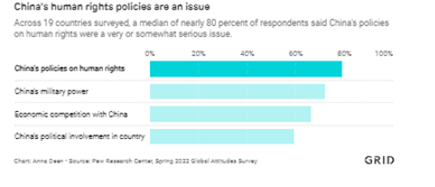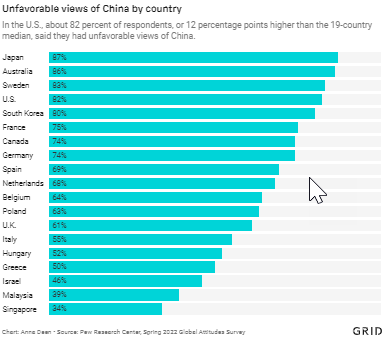Start your day with intelligence. Get The OODA Daily Pulse.
Start your day with intelligence. Get The OODA Daily Pulse.
In a recent Op-Ed by Bill Stanton over at the Taiwan News with the headline “A PRC in decline: A multitude of difficult challenges,” Stanton itemizes the difficulties facing the “Great Power” nation:
“Given the international enthusiasm the PRC (People’s Republic of China) often generated in the past and from which it has profited, chiefly because of its impressive economic growth rates, it is notable how more recent 2022 assessments of China have significantly soured.
This should not be so surprising given the enormous and growing challenges the PRC faces:
Stanton goes on to provide an analysis of “three issues that may be the most serious for the future of the PRC: a decline in economic growth, demographic failure, and growing international distrust and opprobrium.”
Consistent with the largely unfavorable PRC ratings, it is not surprising that of the 19 countries surveyed, a majority of respondents in most countries had little or no confidence in Xi Jinping. More than 80% of Americans, Swedes, Japanese, Australians and South Koreans held such negative views, and more than 60% of most other countries’ citizens who were polled similarly lacked confidence in Xi. The biggest exceptions were again Malaysia and Singapore, which economically depend in large measure on China.

According to the Pew Research Center of the 19 countries surveyed, “a majority of respondents in most countries had little or no confidence in Xi Jinping. More than 80% of Americans, Swedes, Japanese, Australians, and South Koreans held such negative views, and more than 60% of most other countries’ citizens who were polled similarly lacked confidence in Xi. The biggest exceptions were again Malaysia and Singapore, which economically depend in large measure on China.

Interestingly, China’s human rights policies were the key concern of 80% of all respondents across 19 countries. China’s military power followed closely in second place. PRC economic competition and PRC political involvement in other countries’ affairs took third and fourth place, respectively. But all four issues scored as matters of concern to some 60% or more of all those polled across 19 countries.” (4)
Economically, Stanton from the Taiwan News characterizes the PRC’s strategic choices as the need “to replace such non-productive investments by:
Stanton also points out that “the economic growth problem will be difficult to overcome because the policy shifts required will take time and will be politically difficult to adopt given that so many vested interests would be threatened by the necessary changes. Economic decline is also closely linked to a systemic demographic decline that will be difficult to turn around. It is easier to order an increasingly urbanized population of families to have only one child than to persuade, much less command, them to have three.” (1)

“According to the latest Pew Research Center survey released on June 29, 2022, it is evident that few developed countries, especially Western democracies, have positive views of China…’The data from more than 20,000 respondents in 19 advanced economies revealed highly critical views of China on a range of issues, but also a shared view that China’s influence is growing.’ The latest iteration of the Pew survey on attitudes toward China (the first such Pew poll was conducted in 2002) found that perceptions of China are at historically negative levels. Critical views of China spiked in 2020, after the outbreak of the COVID pandemic, but have remained at similar levels since. Of the 19 countries surveyed, the average view was 68% unfavorable toward China.” (1)
Even with all these negative strategic metrics about and perceptions of China, it has been discussed in a few OODA Network monthly meetings and during the 2021 Stratigame exercise, that strategically it is important to “red flag” and be wary of narratives that institutionalize China as THE singular, unilateral geopolitical threat for two reasons:
Still, Stanton concludes with this ominous, valid point: “Nonetheless, for democracies around the world, one potential downside of a PRC in decline is that a frustrated and diminished dragon may decide its best alternative is to lash out at those deemed hostile to its grandiose ambitions. This could mean trouble for democracies in Asia and beyond.”
It should go without saying that tracking threats are critical to inform your actions. This includes reading our OODA Daily Pulse, which will give you insights into the nature of the threat and risks to business operations.
Use OODA Loop to improve your decision-making in any competitive endeavor. Explore OODA Loop
The greatest determinant of your success will be the quality of your decisions. We examine frameworks for understanding and reducing risk while enabling opportunities. Topics include Black Swans, Gray Rhinos, Foresight, Strategy, Strategies, Business Intelligence, and Intelligent Enterprises. Leadership in the modern age is also a key topic in this domain. Explore Decision Intelligence
We track the rapidly changing world of technology with a focus on what leaders need to know to improve decision-making. The future of tech is being created now and we provide insights that enable optimized action based on the future of tech. We provide deep insights into Artificial Intelligence, Machine Learning, Cloud Computing, Quantum Computing, Security Technology, and Space Technology. Explore Disruptive/Exponential Tech
Security and resiliency topics include geopolitical and cyber risk, cyber conflict, cyber diplomacy, cybersecurity, nation-state conflict, non-nation state conflict, global health, international crime, supply chain, and terrorism. Explore Security and Resiliency
The OODA community includes a broad group of decision-makers, analysts, entrepreneurs, government leaders, and tech creators. Interact with and learn from your peers via online monthly meetings, OODA Salons, the OODAcast, in-person conferences, and an online forum. For the most sensitive discussions interact with executive leaders via a closed Wickr channel. The community also has access to a member-only video library. Explore The OODA Community.